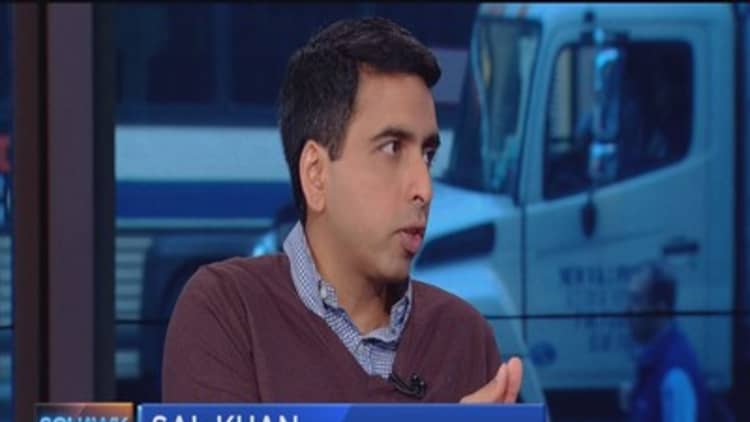It's the rare student who graduates from college debt-free these days. That's not surprising, given how expensive a college education has become. The average cost of tuition, fees, and room and board sets families back an average of $19,000 a year at public four-year colleges and $42,000 at private schools, according to the College Board.
Seven out of 10 college seniors finished their undergraduate degrees with loans, and the average load was $28,400 in 2013, reported the Institute for College Access & Success.
In fact, students often sign on for loans when they're still in high school.
"It's hard to expect someone at that age to make an informed decision," said certified financial planner Catherine Hawley, a California-based certified financial planner and blogger.
A lot hinges on understanding the nuances of loans and getting familiar with how they work.
"Students should start paying off their loans even when they are still in school. This way, it will be at the forefront of their minds," said Renee Mang, founder of Clearwater, Florida-based Edge 2 Edge Consulting, which helps families figure out ways to pay for college. Mang was a loan originator at Sallie Mae, the private-loan lender, for 21 years.
Here are some student loan basics to keep in mind.
Federal vs. private. The vast majority of student loans are of the federal variety, explained Lauren Asher, president of the Institute for College Access & Success. Just 20 percent of undergraduate student debt is financed through private lenders, which is good because federal loans often have better interest rates, repayment options and flexibility.
"You want to avoid private loans like the plague," stressed Jan Miller, founder of Miller Student Loan Consulting in Ashland, Oregon. However, students may need to turn to private loans if they hit the cap on federal loans and still come up short.
However, there are times when federal loans won't cover the full cost of attending college. "It's last option, but a necessary one for many students," said Mang of Edge 2 Edge.
Federal loans can be subsidized or unsubsidized. Subsidized loans are those that don't charge interest while you're in school or during periods of deferment.
Just because you qualify for [an income-driven plan] doesn't mean you should do it. It lowers your payment, but lowering the payment extends the term.Jan Millerfounder of Miller Student Loan Consulting
Unsubsidized loans, on the other hand, do, and the interest gets capitalized, meaning it's added to the principal amount.
Most important, federal loans have many repayment options.
Many ways to pay. When students graduate, they are assigned a standard 10-year repayment schedule. However, there are many other repayment options and consumer protections for federal student loans.
Loan forgiveness. For those who work in the public sector, the balance can be forgiven after 10 years or 120 payments. CFP Daniel Wrenne recommends starting payments while still in school if you think you'll go the nonprofit route. That way, the clock on repayment starts earlier. Wrenne's firm, Wrenne Financial Planning, specializes in advice to young professionals struggling with student loans.
Income-driven plans. If you are toiling away in a low-paying field, you might consider an income-based repayment, a pay-as-you-earn-an-income contingent plan. Your payments are typically capped at a percentage of what the government deems to be your discretionary income. Some of these plans, however, can extend your repayment period beyond the standard 10 years.
"Just because you qualify for [an income-driven plan] doesn't mean you should do it," said Miller of Miller Student Loan Consulting. "It lowers your payment, but lowering the payment extends the term."
Deferments. Deferments allow you to put your loans on hold if you run into financial difficulties or under certain circumstances, such as going back to school for a graduate degree. For most federal loans, you can get deferments for up to three years.
Forbearance. If you can't make your monthly payments but don't qualify for a deferment, you can request to suspend your payments or make reduced payments with a forbearance, usually lasting up to 12 months.

Consolidation vs. refinancing. Interest rates on federal loans get reset every spring. "If you take out federal loans for four years, the rates on all four years can be different," said Asher of the Institute for College Access & Success. For the 2015-2016 academic year, rates run from 4.29 percent for Direct Loans for undergrads to 5.84 percent for Direct Unsubsidized Loans for graduate and professional students.
If you have several different loans, you might think about consolidating them. You won't save any money by doing that — in fact, your payment could rise — but it will be easier to keep track of them if they're all in one place. Consolidation is just the weighted average interest rate rounded up to the next highest eighth of a percent.
Miller, however, doesn't recommend consolidation early on. By consolidating, you'll lock in higher interest rates for some of your lower-rate balances, he argued. Instead, try to pay off your highest interest loans before consolidating.
When it comes to interest rates on private student loans, you might need to shop around, because they can vary. Some run as high as 12 percent and are variable. The rates depend on the borrower's creditworthiness and that of the co-signer.
"When you're just starting out, you aren't a great risk and you don't have a lot of financial history," said Wrenne at Wrenne Financial Planning. That's why rates are so high."
By refinancing when you are earning a salary and have a better credit score, you might be able to lower your interest rates substantially, even as low as 3 percent. However, refinancing is only possible through a private lender. Wrenne cautions that it's not a good idea if you have federal loans, which carry consumer protections you might choose to use at some point.
Student loans come in so many varieties and have so many different repayment options that it pays to take some time to make sense of them all.
— By Ilana Polyak, special to CNBC.com






